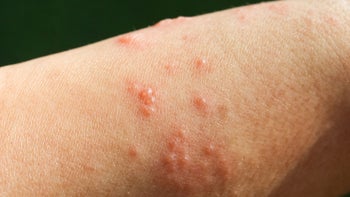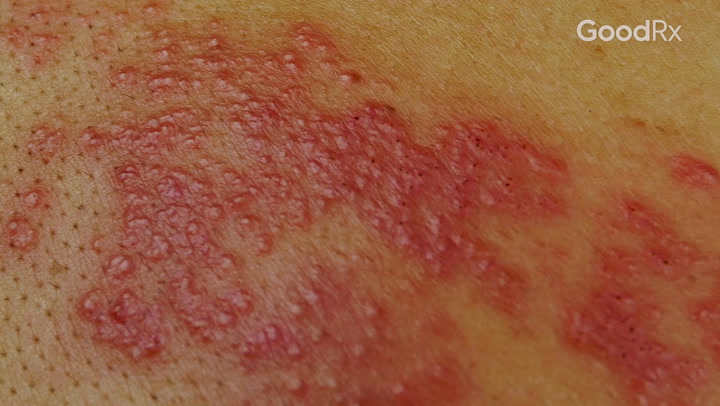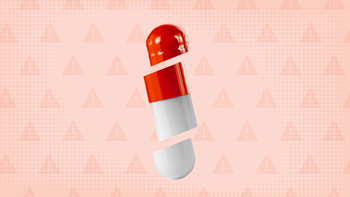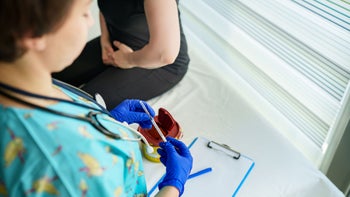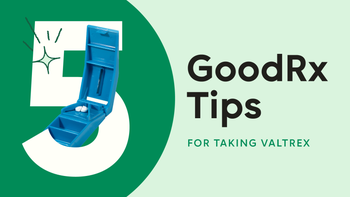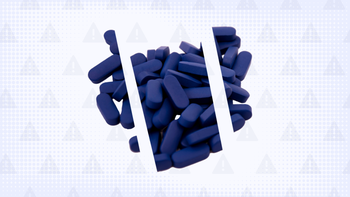
7 Shingles Vaccine Side Effects: What to Expect After Receiving Shingrix
Key takeaways:
The shingles vaccine (Shingrix) can help prevent shingles and the long-lasting pain it can cause.
Shingrix is generally well tolerated. Still, you may have side effects such as arm pain, headache, or fever for a couple of days after receiving the vaccine.
Take it easy and avoid heavy physical activity after your shingles vaccine shot. If needed, an over-the-counter pain reliever, such as acetaminophen (Tylenol) or ibuprofen (Advil, Motrin), may help with bothersome side effects.
Table of contents

Did you know that the same virus that causes chickenpox in children can sometimes reactivate in adults? This is known as shingles, and it happens to 1 out of every 3 people in their lifetime.
Shingles can give you a painful rash on one side of your body that can last for up to 4 weeks. Shooting pain that feels like electricity, called postherpetic neuralgia (PHN), may last for weeks, months, or even years after getting shingles. In severe cases, shingles can lead to blindness, loss of hearing, or even death.
The good news is that there’s a vaccine available to help prevent shingles and its complications. But you may be wondering if the vaccine’s side effects are worth the benefit. For most, temporary discomfort from the shots beats dealing with shingles and PHN.
SHINGRIX (Zoster Vaccine Recombinant, Adjuvanted) is now $0 for almost everyone*
Get SHINGRIX at the pharmacy or in-network doctor’s office today. 98% of privately insured people pay $0 and all Medicare Part D beneficiaries pay $0 at the pharmacy.
Prescribing Information
*Coverage and cost may vary and are subject to change without notice. Reimbursement decisions are made by individual insurance plans.


SHINGRIX is an FDA-approved vaccine for the prevention of shingles (herpes zoster) in adults 50 years and older. SHINGRIX is not used to prevent chickenpox.
• You should not receive SHINGRIX if you are allergic to any of its ingredients or had an allergic reaction to a previous dose of SHINGRIX
• An increased risk of Guillain-Barré syndrome (severe muscle weakness) was observed after vaccination with SHINGRIX
• Fainting can happen after getting injectable vaccines, including SHINGRIX. Precautions should be taken to avoid falling and injury due to fainting
• The most common side effects are pain, redness, and swelling at the injection site, muscle pain, tiredness, headache, shivering, fever, and upset stomach
• SHINGRIX was not studied in pregnant or nursing women. Tell your healthcare provider if you are pregnant, plan to become pregnant, or are breastfeeding
• Vaccination with SHINGRIX may not protect all individuals
• Ask your healthcare provider about the risks and benefits of SHINGRIX. Only a healthcare provider can decide if SHINGRIX is right for you
You are encouraged to report vaccine adverse events to the US Department of Health and Human Services. Visit www.vaers.hhs.gov to file a report, or call 1-800-822-7967.
For US audiences.
Trademarks are property of their respective owners.
©️2024 GSK or licensor.
PMUS-SGXWCNT240015 May 2024
Produced in the USA.
GoodRx Health information and resources are reviewed by our editorial staff with medical and healthcare policy and pricing experience. See our editorial policy for more detail. We also provide access to services offered by GoodRx and our partners when we think these services might be useful to our visitors. We may receive compensation when a user decides to leverage these services, but making them available does not influence the medical content our editorial staff provides.
Shingrix side effects at a glance
While the shingles vaccine side effects can be bothersome, they typically only last 2 to 3 days. More serious side effects after a dose are rare.
Common Shingrix side effects include:
Pain, redness, or swelling at the injection site
Muscle pain
Headache
Stomach pain
Nausea
Fatigue
Fever and chills
Less common but potentially serious Shingrix side effects include:
Guillain-Barré syndrome
Severe allergic reactions
Let’s look more closely at 7 of these side effects and how you can manage them.
1. Injection site reactions
Similar to other vaccine shots, injection site reactions are common after receiving Shingrix. These reactions can include pain, swelling, and redness where Shingrix was injected. Fortunately, injection site reactions are temporary and should resolve within a few days.
In the meantime, there are things you can do to manage this side effect. For redness and swelling, you can try applying an ice pack to the area. And for pain, over-the-counter (OTC) pain relievers, such as acetaminophen (Tylenol), can provide some relief. Tell your healthcare team if your symptoms are getting worse or won’t go away.
2. Headache
Headache is a common Shingrix side effect, reported by about 1 in 3 people during initial clinical trials. Similar to other shingles vaccine side effects, the headaches are usually mild and should get better within a few days. However, headaches that interfere with daily activities tend to be more likely after your second shot.
If needed, you may be able to take an OTC pain reliever for headache pain. Your pharmacist can help you find one that’s safe for you to take.
3. Stomach pain
Some people report stomach pain after receiving Shingrix, which can last for a few days after the injection. This may happen along with other gastrointestinal (GI) side effects, such as nausea, vomiting, and diarrhea.
If you’re experiencing stomach pain, it may help to eat bland, starchy foods that are easier on your stomach. Drink plenty of fluids to stay hydrated. And try to get some rest until the side effects subside.
Contact your healthcare team if your stomach pain lasts longer than a few days, or if it’s getting worse. Stomach pain has many causes, so they can figure out the best course of action.
4. Nausea
Similar to stomach pain, nausea is also possible for a few days after receiving Shingrix. Bland, starchy foods can also be helpful for nausea. And you may want to avoid foods that make nausea worse, such as spicy, high-fat, or acidic foods. Try eating smaller, more frequent meals rather than large meals.
If you need more nausea relief, talk to your pharmacist or prescriber about an OTC nausea medication.
5. Fatigue
You may feel tired after getting Shingrix, especially with your second shot. That’s because your immune system is reacting to the vaccine, which can cause side effects such as fatigue. This is a normal response to many vaccines, including the seasonal flu shot.
Plan to take it easy after your shingles vaccine. Get plenty of rest, and you should notice your energy levels start to improve within a few days.
6. Fever and chills
Some people get fever and chills after getting the shingles vaccine. Similar to fatigue, this is a normal part of your body’s immune response to the vaccine.
Fever and chills from vaccination should get better within a few days. If needed, an OTC fever reducer can help lower a fever. But if your fever lasts longer than a few days, contact your healthcare team. You may have come down with an actual infection.
7. Guillain-Barré syndrome
Guillain-Barré syndrome (GBS) is a rare but serious autoimmune condition that has been reported after the shingles vaccine. GBS happens when your body attacks itself, causing problems with your nervous system. But it’s not clear if GBS is actually caused by the vaccine.
Cases of GBS have been reported within 42 days of vaccination. The most common initial symptom is muscle weakness, usually starting in the legs. But it can start in other places too, such as the arms or head.
Other symptoms of GBS include:
Feeling pins and needles in your hands or feet
Difficulty walking
Shortness of breath
Fast heartbeat or changes in blood pressure
Changes in vision
Severe pain
Loss of bladder control
Loss of bowel function
Seek medical attention immediately if you think you’re experiencing GBS.
When should you contact your healthcare team about Shingrix side effects?
If you’re unsure if you’re experiencing any unusual effects after the shingles vaccine, contact your healthcare team. While many of the side effects can be treated at home, don't overlook these potentially serious conditions.
As with any vaccine, there’s a small risk of a severe allergic reaction (anaphylaxis). After your shot, it’s important to watch for the following symptoms:
Skin itching or hives
Swelling in your face or throat
Trouble breathing
Dizziness
Fast heartbeat or chest pain
Severe weakness
The healthcare professional who gave you the shingles vaccine may have you wait 15 to 30 minutes afterwards to monitor for an allergic reaction. And though these symptoms may start within a couple of minutes, they can also happen hours later. If you experience any of these symptoms after leaving the vaccination site, seek immediate medical attention.
The bottom line
Shingrix is the only vaccine available to prevent shingles and its complications. Common Shingrix side effects include injection site reactions, headache, and stomach pain. Nausea, fatigue, fever, and chills are also possible. These side effects are usually mild and go away within a few days.
If you're thinking about the shingles vaccine, talk to your pharmacist or prescriber for more information.
Why trust our experts?



References
A-S Medication Solutions. (2024). Shingrix [package insert].
Centers for Disease Control and Prevention. (2020). Possible side effects from vaccines.
Centers for Disease Control and Prevention. (2024). About shingles (herpes zoster).
Centers for Disease Control and Prevention. (2024). Shingles symptoms and complications.
U.S. Food and Drug Administration. (2021). FDA requires a warning about Guillain-Barré Syndrome (GBS) be included in the prescribing information for Shingrix.




